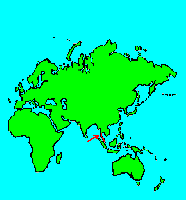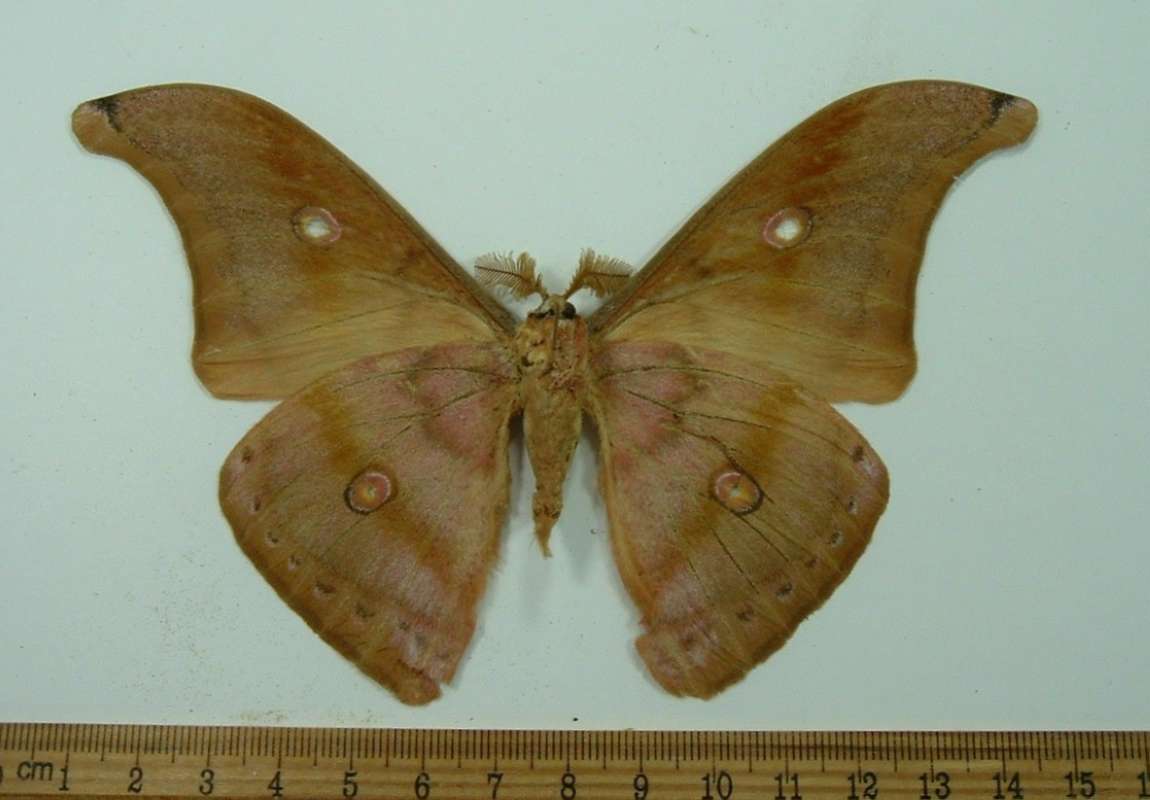SPECIES INFO
Antheraea borneensis was originally described as a subspecies of Antheraea helferi. However, this specimen from Malaysia would indicate that both forms live in Malaysia, and that borneensis deserves species status. Additionally, most Saturnid species breed with little variation across their ranges. (Except for the basic ground color of the wings which usually is very variable.) This specimen is very unlike a normal A. helferi. (Yes, of course, this might have been bred in Malaysia from livestock from Borneo, in which case further research is needed.)The Antheraea genus has been divided into three groups: one in the Old World, and two in the New World.
The Old World Antheraea genus appears to be in need of a revision. However, it appears that Peigler and D'Abrera have taken important steps in that direction. The important recognition coming into view pertains to the A. frithi, A. mylitta, and A. paphia complexes. These three species are found from northern India east through SE Asia and beyond. The first conclusion is that Antheraea mylitta is not a valid name, and those life forms should be referred to Antheraea paphia. The second conclusion observes that Antheraea frithi is an original wild species, and that Antheraea paphia refers to the enormous number of variable lifeforms descending from A. frithi that have escaped from the commercial silk farmers over the last several thousand years and have established themselves as wild populations.
Another question can be asked as to whether Antheraea frithi itself is a colleciton of several different original wild species.
The final question pertains to whether this wild-commercial situation arises in other species group.
Because of the importance of the Antheraea genus for the silk industry, the importance of this group because of their large size and popularity, and the confusing taxonomy, we have divided this genus into nine separate groups.
The first group (Part A) contains the Antheraea assamensis group (now moved into the genus Antheraeopsis).
The second, third, and fourth groups (Parts B, C, and D) contain the species where the female clearly shows a vein in the forewing eyespot. The wild mainland Antheraea frithi belongs here as Part B. The insular species with said vein belong here as part C. Also the commercial lifeforms with the vein including A. mylitta and A. paphia belong here as part D.
The fifth group (Part E) contains Antheraea roylei, pernyi, and their close relatives.
The sixth group (Part F) includes the A. helferi and A. imperator group.
The seventh group (Part G) contains several additional Antheraea species found in the mainland and the area south to Malaysia.
The eighth group (Part H) contains several additional Antheraea species found in the insular group which includes the Philippines and Indonesia.
The ninth group (Part I) contains those Antheraea in the New Guinea and Australia group in the Opodipthera genus.
This group of Antheraea moths contains the species that remain after we have removed the Antheraeopsis, Antheraea frithi-mylitta, Antheraea pernyi-roylei, and A. helferi species. These are all found on the mainland from India to Malaysia and east into China and Japan.
Saturnid moths (family Saturnidae)are the giants of the moth world. They are usually characterized by their unique feather-like antennae. Males usually have larger antennae used to locate the females. Many species have transparent eye spots on their wings.
Typically, the males find the females upon emergence and copulate immediately. The United States government has frequently researched the sensing mechanism that permits the males to find the females in hopes of finding a military application.
Butterflies and Moths (Order Lepidoptera) are a group of insects with four large wings. They go through various life cycles including eggs, caterpillar (larvae), pupae, and adult. Most butterflies and moths feed as adults, but primarily do most of their growing in the larval or caterpillar stage. Also, most species are restricted to feeding as caterpillars upon a unique set of plants. In this pairing of insects to plants, there arises a unique plant population control system. When one plant species becomes too common, specific pests to that species also become more common and thus prevent the further spreading of that particular plant species.
Although most people think of the Lepidoptera as two different groups: butterflies and moths, technically, the concept is not valid.
Some families, such as Silk Moths (Saturnidae) and Hawk Moths (Sphingidae), are clearly moths. Other families, such as Swallowtail Butterflies (Papilionidae), are clearly butterflies, However, several families exhibit characteristics that appear to be neither moths nor butterflies. For example: the Castnia Moths of South America are frequently placed in the Skipper Family (Hesperidae). The Sunset Moths (Uranidae) have long narrow antennae and fly during the day.
The Saturnidae (Silk Moths) and Papilionidae (Swallowtails) are two Lepidoptera families that have been very carefully researched as to species and subspecies. The current thinking is that if the male genitalia are alike, then the two specimens belong to the same species. As an amateur, your editor disagrees with this premise. If the genitalia are different, then no doubt two species are involved. However, if the genitalia are alike, it only proves that the genitalia are alike.
Consider Papilio multicaudata which is found in southern Canada at higher altitudes. Papilio multicaudata is found south through the Rocky Mountains as far south as Mexico City, and recently as far south as Guatemala. With different food plants, different soil types, different climates, and different seasonal patterns, it is hard to believe that this complex is all one species.
Consider capturing 100 living individuals at any life stage in Guatemala and then carrying them north to southern Canada. Would these individuals survive through several generations. If they would not survive, then this author would conclude that two different species are involved!
In the Saturnidae consider Eacles imperialis subspecies pini. This life form feeds on pines. Is not this sufficient to justify a full species status?
Note: Numerous museums and biologists have loaned specimens to be photographed for this project.
Insects (Class Insecta) are the most successful animals on Earth if success is measured by the number of species or the total number of living organisms. This class contains more than a million species, of which North America has approximately 100,000. (Recent estimates place the number of worldwide species at four to six million.)
Insects have an exoskeleton. The body is divided into three parts. The foremost part, the head, usually bears two antennae. The middle part, the thorax, has six legs and usually four wings. The last part, the abdomen, is used for breathing and reproduction.
Although different taxonomists divide the insects differently, about thirty-five different orders are included in most of the systems.
The following abbreviated list identifies some common orders of the many different orders of insects discussed herein:
Odonata: - Dragon and Damsel Flies
Orthoptera: - Grasshoppers and Mantids
Homoptera: - Cicadas and Misc. Hoppers
Diptera: - Flies and Mosquitoes
Hymenoptera: - Ants, Wasps, and Bees
Lepidoptera: - Butterflies and Moths
Coleoptera: - Beetles
Jointed Legged Animals (Phylum Arthropoda) make up the largest phylum. There are probably more than one million different species of arthropods known to science. It is also the most successful animal phylum in terms of the total number of living organisms.
Butterflies, beetles, grasshoppers, various insects, spiders, and crabs are well-known arthropods.
The phylum is usually broken into the following five main classes:
Arachnida: - Spiders and Scorpions
Crustacea: - Crabs and Crayfish
Chilopoda: - Centipedes
Diplopoda: - Millipedes
Insecta: - Insects
There are several other "rare" classes in the arthropods that should be mentioned. A more formal list is as follows:
Sub Phylum Chelicerata
C. Arachnida: - Spiders and scorpions
C. Pycnogonida: - Sea spiders (500 species)
C. Merostomata: - Mostly fossil species
Sub Phylum Mandibulata
C. Crustacea: - Crabs and crayfish
Myriapod Group
C. Chilopoda: - Centipedes
C. Diplopoda: - Millipedes
C. Pauropoda: - Tiny millipede-like
C. Symphyla: - Garden centipedes
Insect Group
C. Insecta: - Insects
The above list does not include some extinct classes of Arthropods such as the Trilobites.
Animal Kingdom contains numerous organisms that feed on other animals or plants. Included in the animal kingdom are the lower marine invertebrates such as sponges and corals, the jointed legged animals such as insects and spiders, and the backboned animals such as fish, amphibians, reptiles, birds, and mammals.



